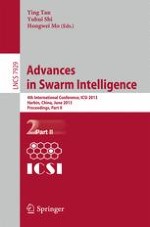This book and its companion volume, LNCS vols. 7928 and 7929 constitute the proceedings of the 4th International Conference on Swarm Intelligence, ICSI 2013, held in Harbin, China in June 2013. The 129 revised full papers presented were carefully reviewed and selected from 268 submissions. The papers are organized in 22 cohesive sections covering all major topics of swarm intelligence research and developments. The topics covered in this volume are: hybrid algorithms, swarm-robot and multi-agent systems, support vector machines, data mining methods, system and information security, intelligent control, wireless sensor network, scheduling and path planning, image and video processing, and other applications.
